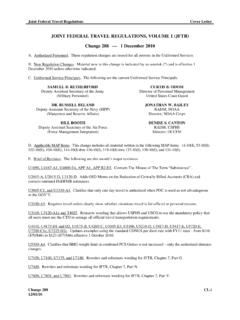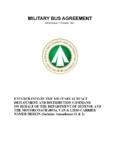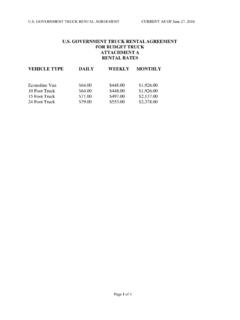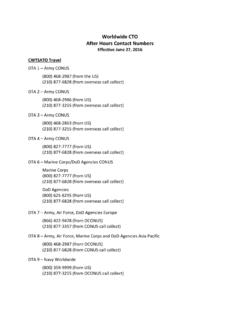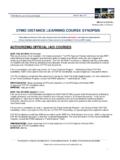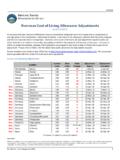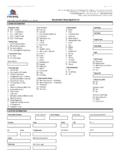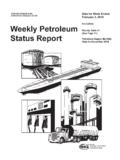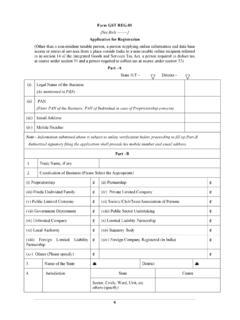Transcription of For the Uniformed Services
1 January 2018 The purpose of this Basic allowance for housing (BAH) primer is to explain to members how their housing allowances are determined. We have sought to write for a broad audience and to cover the entire process. We have focused on what we believe to be the most important aspects of the program based on feedback obtained from service members and housing office professionals during our visits to installations throughout the country. We welcome comments on how this document can be more useful to both members and housing officials. DEFENSE TRAVEL MANAGEMENT OFFICE A Primer on the Basic allowance for housing (BAH) For the Uniformed Services BAH Primer January 2018 Defense Travel Management Office Table of Contents Basic allowance for housing .
2 1 1. Purpose and 2. Benefits of BAH ..1 3. Individual Rate Protection ..1 Data Collection .. 2 4. Types of Data Collected ..2 5. Rental Data Sources & Validation ..2 Utilities ..3 Quality Assurance ..3 Local Input in the Data Collection Process .. 4 6. Tapping Local Expertise ..4 7. Typical Data Collection Timeline ..4 8. Geographically Separated Activities ..4 9. Individual Service Member Input ..4 Rate Computations .. 5 10. housing Profiles and Standards ..5 11. BAH housing Standards & Interpolation Between Anchor Points ..6 12. Setting the Rates ..7 13. Frequently Asked Questions .. 7 14. Why doesn t BAH cover all my housing costs, or my mortgage payment? ..7 15. How will the out of pocket impact service members? ..8 16. Why is BAH based on my duty station rather than where I live? ..8 17. Why can I get a bigger or better residence on-base/post?
3 9 18. What is the basis for the current definition of my MHA? ..9 19. What method do you use to calculate BAH in locations that are not in an MHA? ..9 Obtaining More Information .. 11 BAH Primer January 2018 Defense Travel Management Office 1 Basic allowance for housing 1. Purpose and Goal The purpose of the Basic allowance for housing (BAH) program is to provide fair housing allowances to service members. The goal of the program is to help members cover the costs of housing in the private sector; therefore, rental- housing costs in the private sector are the basis for the allowance . Members receive a housing allowance when government quarters are not available.
4 DoD determines an equitable housing allowance to enable members to afford suitable rental housing near their duty location. The allowance is set based on geographic duty location, pay grade, and dependent status. 2. Benefits of the Basic allowance for housing The Department of Defense and the Services designed the BAH program to provide accurate housing allowances based on the market price of rental housing rather than member-reported rents. The BAH program measures rental- housing costs in the civilian market rather than measuring how much members spend on housing . This method ensures a more accurate correlation between allowance payments and rental prices. 3. Individual Rate Protection Individual rate protection prevents decreases in housing allowances (due to the incorporation of an out-of-pocket expense, declining rental/utility prices in the area, or a combination of the two), as long as the status of a service member remains unchanged.
5 This ensures that members who have made long-term commitments in the form of a lease or contract are not penalized if the area's housing costs decrease. Service members are entitled to the BAH rates published 1 January or the amount of housing allowance they received on 31 December, whichever is larger. Rate protection continues unless the status of a service member changes due to: Permanent Change of Station (PCS) Reduction in paygrade Change in dependent status BAH distinguishes between with-dependents and without-dependents, not the number of dependents. After a service member arrives at a new duty station, rate protection applies. The service member will receive any published increase, but no decrease, in BAH if their status remains the same. The definition of change in status does not include promotions. If a service member is promoted, and is in a location where the current published BAH rate for the new grade is lower than the BAH amount received before, they continue to receive the higher BAH amount.
6 BAH Primer January 2018 Defense Travel Management Office 2 Data Collection 4. Type of Data Collected In computing BAH, DoD includes local price data for: rental housing utilities (including electricity, heating fuel, water, & sewer) We employ a contractor to collect the data annually for approximately 300 Military housing Areas (MHAs) in the United States, including Alaska and Hawaii. DoD and the Services define these MHAs by sets of ZIP Codes. Nation-wide data collection occurs in the spring and summer when housing markets are most active. Rental costs are collected for apartments, townhouses/duplexes, and single-family rental units of varying bedroom sizes.
7 The different types of units are referred to as profiles or anchor points. DoD uses housing profiles to link rental costs with particular paygrades. The six standard housing profiles used as anchor points for BAH are: Profile Grade With Dependents Grade Without Dependents 1 Bedroom Apartment E-4 2 Bedroom Apartment O-1 2 Bedroom Townhouse/Duplex E-5 O-1E 3 Bedroom Townhouse/Duplex E-6 O-3E 3 Bedroom Single Family Detached House W-3 O-6 4 Bedroom Single Family Detached House O-5 5. Rental Data Sources and Validation Current, valid rental costs are crucial to accurate BAH rates. We use data from multiple sources to provide a "checks and balances" approach. This ensures reliability and accuracy. We obtain current residential vacancies from local newspapers and real estate rental listings. We also contact apartment and real estate management companies to identify units for rental pricing.
8 We consult with real estate professionals in each MHA to confirm market rental prices and obtain additional data. Where available, we also contact fort/post/base housing referral offices and installation leadership. We tap the local housing office knowledge and gain insights into the concerns of our members. Properties are subjected to additional screening and validation processes. Current, up-to-date rental information from telephone interviews and the internet is utilized from contacts provided by the local housing offices. During telephone interviews we: Establish the availability and location of each unit in the survey sample Verify the current rental rates Identify any utility inclusions in the rental rates Determine if discounts are available when signing a year s lease BAH Primer January 2018 Defense Travel Management Office 3 We do not include inadequate units in determining allowances, such as Mobile homes Efficiency apartments Furnished units Income-subsidized complexes Age-restricted facilities Seasonal units We gather enough data to attain a 95% statistical confidence that the estimated median rent is within 10% of the true median rent.
9 Utilities The Bureau of the Census conducts an annual American Community Survey (ACS). We use data from the ACS to determine average expenditures for utilities specific to each dwelling type in each MHA. All data is sensitive to local housing conditions, geography, and climate. Quality Assurance We recognize the importance of accurate rates and make every effort to obtain maximum reliability. At each step in the process, we: Employ numerous levels of quality assurance Analyze statistics to spot problems Apply common sense tests to the data For example, we employ a multi-tiered screening process when we select specific units to measure. We ensure units are suitable and appropriate, and that they are geographically distributed in approximately the same manner as the civilian population. We obtain input on suitable housing and unacceptable areas from Military housing Offices (MHOs) and installation leadership.
10 We also use an income screening process to identify appropriate neighborhoods. We then eliminate locations where the typical civilian income is not comparable to members incomes. For comparison purposes, civilian salary equivalents are compared to each pay grade s Regular Military Compensation, which consists of basic pay, average BAH, Basic allowance for Subsistence (BAS), and the tax advantage that comes with BAH and BAS being untaxed. As another quality assurance step, DoD and the Services conduct on-site evaluations at selected locations. These reviews confirm the reliability and accuracy of the rental data. During these visits, we also evaluate the criteria used for screening neighborhoods and areas. BAH Primer January 2018 Defense Travel Management Office 4 Local Input in the Data Collection Process 6.


